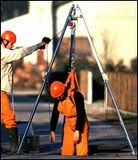OSHA Confined Spaces
Requirements for employees and employers
By Bill Clark
What is the definition of a confined space? According to OSHA, a confined space is defined as an area large enough for entry with a limited ability to enter and exit and is not intended for continuous occupancy. If you have to duck, crawl, climb or squeeze into the space then it is more than likely a confined space. That means a water and wastewater systems has numerous confined spaces.
If a confined space, as identified above, has any one of following hazards then it is a permit-required confined space; oxygen deficiency, the potential for buildup of toxic or explosive gases, engulfment and chemical hazards.

Photo courtesy of OSHA.gov
Employers are required by OSHA to evaluate all work places and identify all permit required confined spaces. Employers are required to provide training to all employees who enter permit-required confined spaces.
Examples of permit-required confined spaces are: wastewater lift stations, manholes, wastewater collection systems, meter pits, valve pits, storage tanks and chemical feed systems that are underground.
According to OSHA you must monitor the atmosphere in a permit required confined space with calibrated gas detectors continuously.
For more information on job responsibilities and other OSHA confined space requirements, go to OSHA regulation 29 CFR 1910.146 or your DEQ water or wastewater study guide.
Some gases in confined spaces that can kill you are odorless and colorless. Think and test the air before entering a confined space. Remember your confined space training ‑ use the buddy system.





